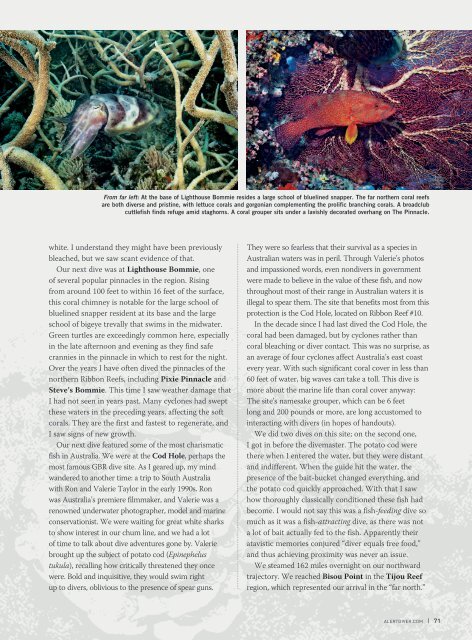AD 2018 Q1
Alert Diver is the dive industry’s leading publication. Featuring DAN’s core content of dive safety, research, education and medical information, each issue is a must-read reference, archived and shared by passionate scuba enthusiasts. In addition, Alert Diver showcases fascinating dive destinations and marine environmental topics through images from the world’s greatest underwater photographers and stories from the most experienced and eloquent dive journalists in the business.
Alert Diver is the dive industry’s leading publication. Featuring DAN’s core content of dive safety, research, education and medical information, each issue is a must-read reference, archived and shared by passionate scuba enthusiasts. In addition, Alert Diver showcases fascinating dive destinations and marine environmental topics through images from the world’s greatest underwater photographers and stories from the most experienced and eloquent dive journalists in the business.
Create successful ePaper yourself
Turn your PDF publications into a flip-book with our unique Google optimized e-Paper software.
From far left: At the base of Lighthouse Bommie resides a large school of bluelined snapper. The far northern coral reefs<br />
are both diverse and pristine, with lettuce corals and gorgonian complementing the prolific branching corals. A broadclub<br />
cuttlefish finds refuge amid staghorns. A coral grouper sits under a lavishly decorated overhang on The Pinnacle.<br />
white. I understand they might have been previously<br />
bleached, but we saw scant evidence of that.<br />
Our next dive was at Lighthouse Bommie, one<br />
of several popular pinnacles in the region. Rising<br />
from around 100 feet to within 16 feet of the surface,<br />
this coral chimney is notable for the large school of<br />
bluelined snapper resident at its base and the large<br />
school of bigeye trevally that swims in the midwater.<br />
Green turtles are exceedingly common here, especially<br />
in the late afternoon and evening as they find safe<br />
crannies in the pinnacle in which to rest for the night.<br />
Over the years I have often dived the pinnacles of the<br />
northern Ribbon Reefs, including Pixie Pinnacle and<br />
Steve’s Bommie. This time I saw weather damage that<br />
I had not seen in years past. Many cyclones had swept<br />
these waters in the preceding years, affecting the soft<br />
corals. They are the first and fastest to regenerate, and<br />
I saw signs of new growth.<br />
Our next dive featured some of the most charismatic<br />
fish in Australia. We were at the Cod Hole, perhaps the<br />
most famous GBR dive site. As I geared up, my mind<br />
wandered to another time: a trip to South Australia<br />
with Ron and Valerie Taylor in the early 1990s. Ron<br />
was Australia’s premiere filmmaker, and Valerie was a<br />
renowned underwater photographer, model and marine<br />
conservationist. We were waiting for great white sharks<br />
to show interest in our chum line, and we had a lot<br />
of time to talk about dive adventures gone by. Valerie<br />
brought up the subject of potato cod (Epinephelus<br />
tukula), recalling how critically threatened they once<br />
were. Bold and inquisitive, they would swim right<br />
up to divers, oblivious to the presence of spear guns.<br />
They were so fearless that their survival as a species in<br />
Australian waters was in peril. Through Valerie’s photos<br />
and impassioned words, even nondivers in government<br />
were made to believe in the value of these fish, and now<br />
throughout most of their range in Australian waters it is<br />
illegal to spear them. The site that benefits most from this<br />
protection is the Cod Hole, located on Ribbon Reef #10.<br />
In the decade since I had last dived the Cod Hole, the<br />
coral had been damaged, but by cyclones rather than<br />
coral bleaching or diver contact. This was no surprise, as<br />
an average of four cyclones affect Australia’s east coast<br />
every year. With such significant coral cover in less than<br />
60 feet of water, big waves can take a toll. This dive is<br />
more about the marine life than coral cover anyway:<br />
The site’s namesake grouper, which can be 6 feet<br />
long and 200 pounds or more, are long accustomed to<br />
interacting with divers (in hopes of handouts).<br />
We did two dives on this site; on the second one,<br />
I got in before the divemaster. The potato cod were<br />
there when I entered the water, but they were distant<br />
and indifferent. When the guide hit the water, the<br />
presence of the bait-bucket changed everything, and<br />
the potato cod quickly approached. With that I saw<br />
how thoroughly classically conditioned these fish had<br />
become. I would not say this was a fish-feeding dive so<br />
much as it was a fish-attracting dive, as there was not<br />
a lot of bait actually fed to the fish. Apparently their<br />
atavistic memories conjured “diver equals free food,”<br />
and thus achieving proximity was never an issue.<br />
We steamed 162 miles overnight on our northward<br />
trajectory. We reached Bisou Point in the Tijou Reef<br />
region, which represented our arrival in the “far north.”<br />
ALERTDIVER.COM | 71









